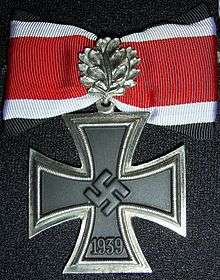Bruno Streckenbach
| Bruno Streckenbach | |
|---|---|
 SS-Gruppenführer Bruno Streckenbach | |
| Born |
7 February 1902 Hamburg, German Empire |
| Died |
28 October 1977 (aged 75) Hamburg, West Germany |
| Allegiance |
|
| Service/branch |
|
| Years of service | 1918–45 |
| Rank | SS-Gruppenführer and Generalleutnant of the Waffen-SS and Polizei |
| Service number |
NSDAP #489,972 SS #14,713 |
| Commands held |
8th SS Cavalry Division Florian Geyer 19th Waffen Grenadier Division of the SS (2nd Latvian) |
| Battles/wars |
World War II |
| Awards | Knight's Cross of the Iron Cross with Oak Leaves |
| Other work | general manager ADAC |
Bruno Heinrich Streckenbach (7 February 1902 – 28 October 1977) was a high-ranking member (SS-Gruppenführer) in the SS, who was was the head of Administration and Personnel Department of the Reich Main Security Office (Reichssicherheitshauptamt or RSHA). He was responsible for many thousands of murders committed by Nazi mobile killing squads known as Einsatzgruppen.
SS career
Allgemeine-SS
Streckenbach served in the last year of World War I and was a member of the Freikorps between the wars. He was appointed in 1933 to run the Hamburg political police after it had been swallowed by the SS as Heinrich Himmler and Reinhard Heydrich took over one state police force after another in their plan to control the national police of Nazi Germany. He was transferred to Poland after the German occupation of 1939; he oversaw the arrests of the professors at Cracow University, and was one of the architects of the effective implementation of the Extraordinary Pacification Action. He was then posted to Berlin for administrative duties.
Streckenbach received a top secret order to proceed immediately to the police barracks at Pretzsch on the Elbe. He was met there by members of the SD, the Waffen-SS, the Gestapo and the Orpo police. Streckenbach trained and indoctrinated them before the invasion of the Soviet Union. Veterans of German atrocity in Poland became members of one of four newly constituted Einsatzgruppen destined for Soviet Russia.
Streckenbach detailed the mission of the Einsatzgruppen: they were to seize and destroy all political and racial enemy groups, such as Bolsheviks, gypsies, partisans and Jews. In addition, the Einsatzgruppen were to report on and evaluate material seized during the campaign and to gather information from agents among the Soviet population. Streckenbach ordered that all enemies of the Third Reich were to be deported to concentration camps and executed. Jews were especially singled out for Sonderbehandlung ("special treatment"), meaning extermination. On 9 November 1941 he was promoted to SS-Gruppenführer und Generalleutnant der Polizei.
Waffen-SS
Streckenbach then requested to join a combat unit, and in September 1942 he was transferred to the Waffen-SS. He was assigned to the 8th SS Cavalry Division Florian Geyer in March 1943. By April 1943 he was in command of the division's anti-tank battalion. Later in the autumn he replaced Hermann Fegelein as a divisional commander, and was promoted to SS-Oberführer on 30 January 1944.
On 13 April 1944 he was appointed commander of the 19th Waffen Grenadier Division of the SS (2nd Latvian). Streckenbach held this post to the end of the war; he achieved the rank of SS-Gruppenführer und Generalleutnant der Waffen-SS in November 1944. Streckenbach was awarded the Knight's Cross, and later the Oak Leaves.
Post-war
Streckenbach was taken prisoner by the Soviets and, in 1952, he was sentenced to serve twenty-five years in prison, but was released on 10 October 1955. During the Nuremberg trial, defendant Otto Ohlendorf stated that Streckenbach, in mid-June 1941, had transmitted the extermination order, at a meeting concerning the missions of the Einsatzgruppen.
The West German government eventually brought Streckenbach to trial in 1973 but the case was dismissed due to defendant's ill health.[1] He died on 28 October 1977 in Hamburg.
Awards
- Iron Cross (1939) 2nd Class (10 October 1940) & 1st Class (15 July 1943)[2]
- German Cross in Gold on 15 December 1943 as SS-Standartenführer in the SS-Kavallerie-Division[3]
- Knight's Cross of the Iron Cross with Oak Leaves
- Mentioned three times in the Wehrmachtbericht on 9 August 1944, 30 September 1944 and 27 December 1944
References
Citations
- ↑ Blood 2006, p. 324.
- ↑ Thomas 1998, p. 360.
- ↑ Patzwall & Scherzer 2001, p. 464.
- 1 2 Scherzer 2007, p. 730.
Bibliography
- Blood, Phillip W. (2006). Hitler's Bandit Hunters: The SS and the Nazi Occupation of Europe. Potomac Books. ISBN 978-1597970211.
- Patzwall, Klaus D.; Scherzer, Veit (2001). Das Deutsche Kreuz 1941 – 1945 Geschichte und Inhaber Band II [The German Cross 1941 – 1945 History and Recipients Volume 2] (in German). Norderstedt, Germany: Verlag Klaus D. Patzwall. ISBN 978-3-931533-45-8.
- Scherzer, Veit (2007). Die Ritterkreuzträger 1939–1945 Die Inhaber des Ritterkreuzes des Eisernen Kreuzes 1939 von Heer, Luftwaffe, Kriegsmarine, Waffen-SS, Volkssturm sowie mit Deutschland verbündeter Streitkräfte nach den Unterlagen des Bundesarchives [The Knight's Cross Bearers 1939–1945 The Holders of the Knight's Cross of the Iron Cross 1939 by Army, Air Force, Navy, Waffen-SS, Volkssturm and Allied Forces with Germany According to the Documents of the Federal Archives] (in German). Jena, Germany: Scherzers Miltaer-Verlag. ISBN 978-3-938845-17-2.
- Thomas, Franz (1998). Die Eichenlaubträger 1939–1945 Band 2: L–Z [The Oak Leaves Bearers 1939–1945 Volume 2: L–Z] (in German). Osnabrück, Germany: Biblio-Verlag. ISBN 978-3-7648-2300-9.
- Die Wehrmachtberichte 1939–1945 Band 3, 1. Januar 1944 bis 9. Mai 1945 [The Wehrmacht Reports 1939–1945 Volume 3, 1 January 1944 to 9 May 1945] (in German). München, Germany: Deutscher Taschenbuch Verlag GmbH & Co. KG. 1985. ISBN 978-3-423-05944-2.
| Military offices | ||
|---|---|---|
| Preceded by SS-Gruppenführer Hermann Fegelein |
Commander of 8th SS Cavalry Division Florian Geyer 13 September 1943 – 22 October 1943 |
Succeeded by SS-Gruppenführer Hermann Fegelein |
| Preceded by SS-Gruppenführer Hermann Fegelein |
Commander of 8th SS Cavalry Division Florian Geyer 1 January 1944 – 13 April 1944 |
Succeeded by SS-Brigadeführer Gustav Lombard |
| Preceded by SS-Standartenführer Friedrich-Wilhelm Bock |
Commander of 19th Waffen Grenadier Division of the SS (2nd Latvian) 13 April 1944 – 8 May 1945 |
Succeeded by none |

